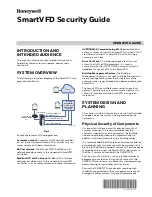
Dynamic Save Button
Unprogrammed buttons at multiline telephones are available for the user to dynamically save dialed
numbers. To save a number, the user presses any unprogrammed button before hanging up after he or she
has dialed a number. To dial the saved number, the user presses the same button and the system
automatically dials the saved number. Saving a number over a previously saved number erases the old
one and stores the new one in place of it.
E
E1 Digital Carrier Transmission Option (International Applications)
The E1 digital carrier transmission option is designed for international applications and allows up to 30
channels of voice and/or data transmissions over a single four-wire cable using multiplexing techniques.
For convenience, a customer service unit (CSU) is built into the E1 option board to terminate the E1
channels, provide protection from transient voltages, and respond to loop-back requests from the central
office.
Up to four E1 boards can be installed if the expansion cabinet has been added to the main cabinet – two
boards in each cabinet. The DXOPT-SYN card on the Services board must be installed whenever one or
more E1 boards is installed, and the DXP Plus is receiving its timing signals from an external source. In
installations where the local DXP Plus is supplying the clock signal for the far system, no DXOPT-SYN
card is required in the local DXP Plus.
You can assign a system status button to a station and enable the system to report E1 transmission errors
via the T1/E1 status log. Depending on how you program the system, the E1 status log either prints out on
an optional printer or is displayed on an optional video display terminal (VDT). You can also view the E1
status log from an LCD speakerphone by programming a system status button.
Also, you can program the system to alert the system attendant whenever a major alarm alerting condition
occurs by activating an external, customer-supplied audible or visual alarm. The external alarm connects
to one of the relay jacks (J3 or J4) on the front of the CPU board. Make sure the alarming device complies
with system voltage and power requirements. You determine when a major alarm alerting condition
should occur by programming threshold values and corresponding time periods for each type of alarm
caused by a transmission error. Whenever the threshold value is reached within the programmed time
period, the selected relay on the CPU board is activated by the board’s circuits, which in turn, activates
the external alarm. The system attendant can turn the alarm off from any specified station by dialing a
feature code.
Pad Level—Transmit, Receive
(Gain And Attenuation Settings For Line Transmit And Receive)
This feature enhances the T1–E1 digital carrier transmission option, the pad level programming feature
adjusts voice levels for both the transmit and receive circuits in the individual channels.
The choices include: Gain 2, Gain 1, Nominal, Loss 1, Loss 2, Loss 3, Loss 4, and Loss 5. These settings
provide an appro6 to -15 dB range of choices. Starting at the Nominal setting, each gain level
represents an approximate 3 dB amplification of the signal level from the previous setting, and each loss
level represents an approximate 3 dB attenuation of the signal level from the previous setting. Because
digital transmission does not lose volume level as readily as analog transmission does, it is likely that the
receive level may be noticeably higher when using the E1 option. Therefore, you may need to select a low
setting such as Loss 2 for the voice level receive parameter when programming this feature for E1 lines
that are being used exclusively for voice transmission. Further, if you choose a setting to increase the
receive gain, you should carefully examine speakerphone operation. It is possible to select a receive gain
that will, under certain conditions, interfere with proper speakerphone operation.
DXP Plus General Description
GCA40–130
Understanding The Features – 75
Содержание DXP Plus Series
Страница 1: ...Digital Communications System R ...
Страница 363: ...Automatic Call Distributor Technical Manual R QuickQ DXP ...
Страница 424: ...Automatic Call Distributor System Manager s Guide R QuickQ DXP ...
Страница 500: ...Wrap up Time 1 6 Wrapping Up A Call 4 3 Z Zoom Box A 2 GCA70 271 Index I 3 ...
Страница 628: ...Interconnecting The VMI X Installing And Programming For ExecuMail IMI89 206 Installing And Programming For ExecuMail 5 ...
Страница 677: ...Connecting The Equipment Installing And Programming The OPX X IMI89 209 Installing The OPX X 7 ...
Страница 728: ...DP I I I I and FX Series Digital Communications Systems Understanding The Visual Man Machine Interface COMDlA ...
Страница 1112: ...9 08 8 90 1 13 4 78 3 94 UNIS029 TAB003 PLS page 6 GCA40 130 DXP Plus General Description 11B Telephone Features ...
















































